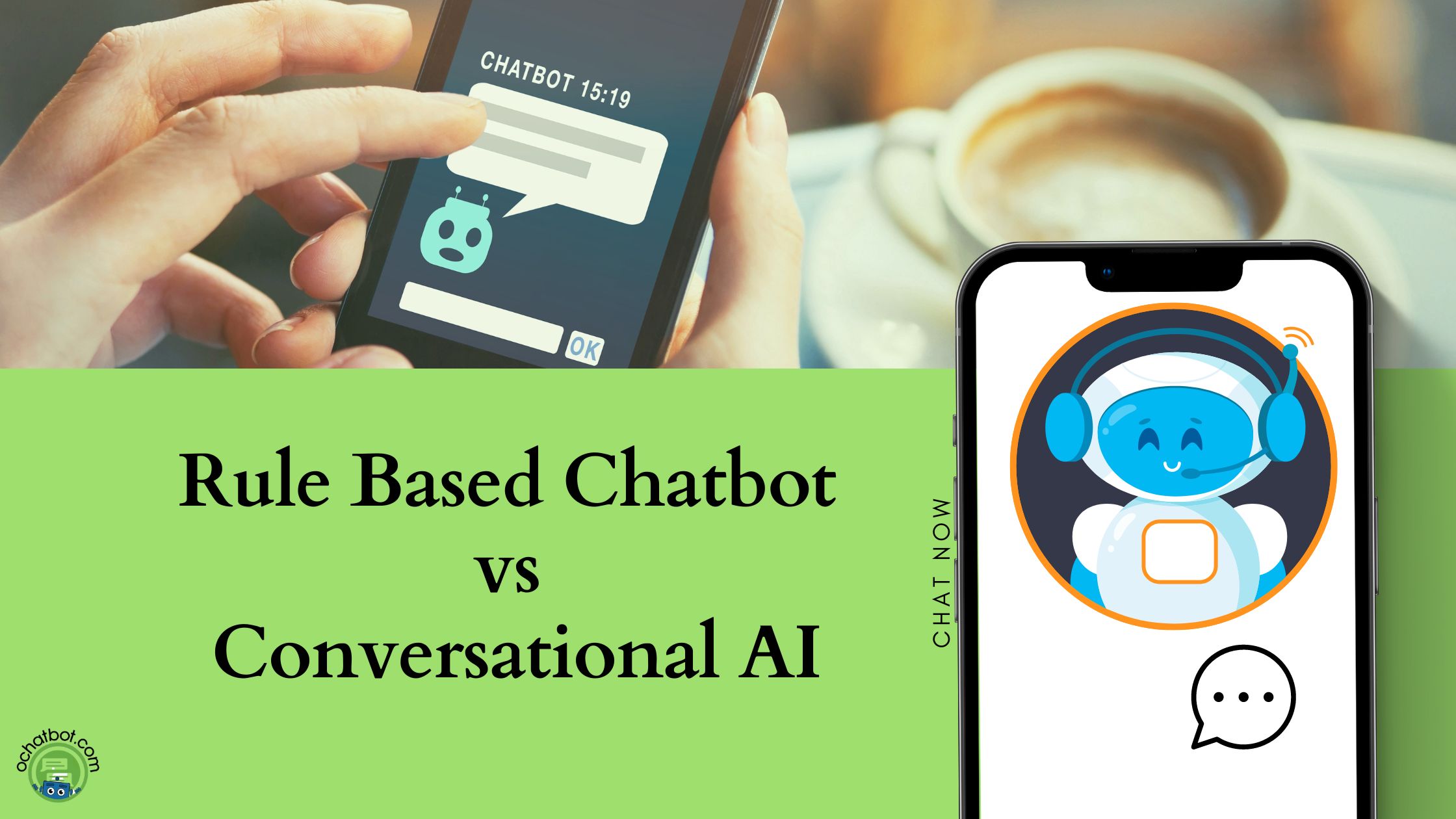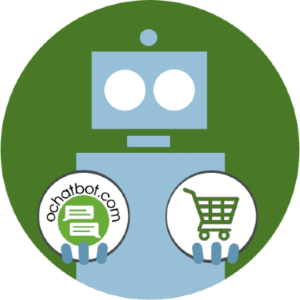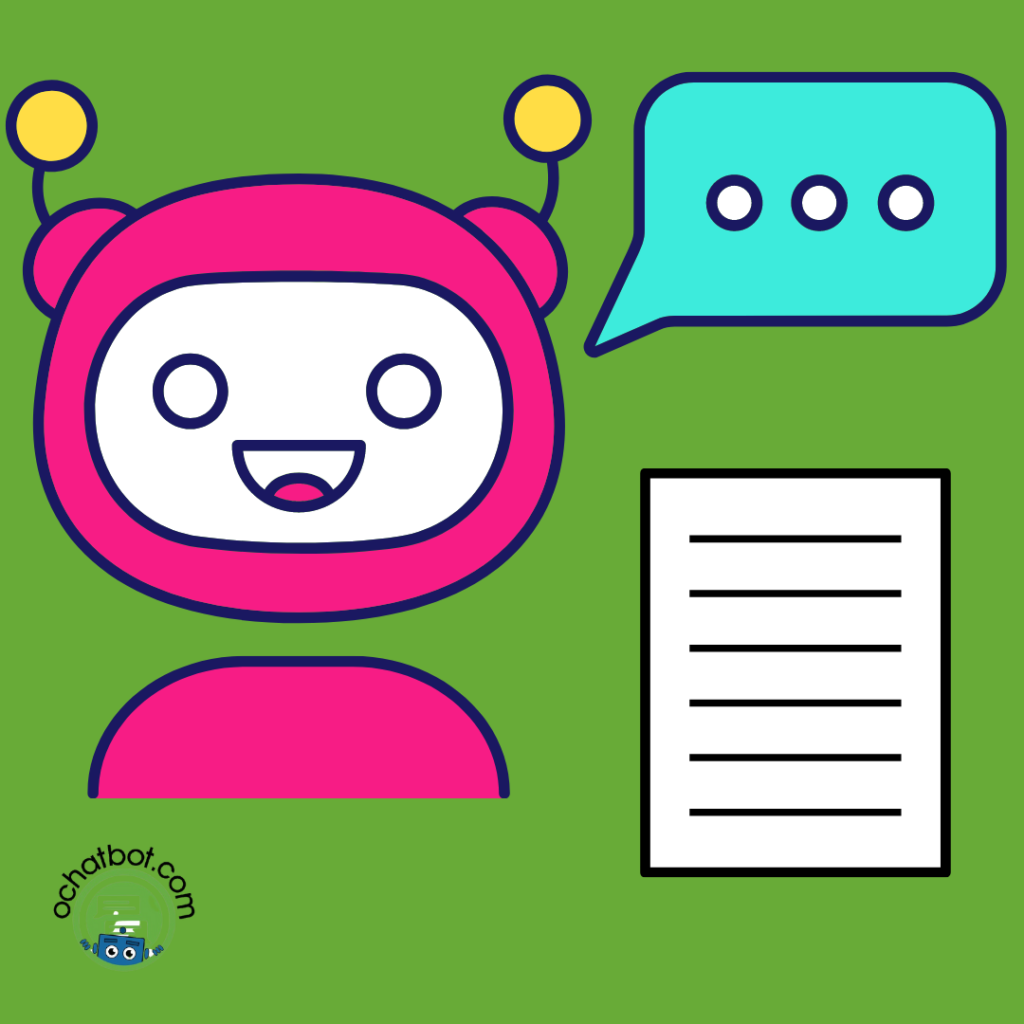
Do you want to know what a rule-based chatbot is? Are you confused between a Rule-based chatbot and Conversational AI? Online business is growing every day, and marketers are adding advanced technologies to their websites to create brand awareness and sell their ideas.
E-commerce websites are optimizing their landing pages with technologies to invite more website visitors. A Chatbot is one of those advanced technologies increasingly attracting the attention of online business owners.
Overview of the Content
Advantages of Rule-based chatbots
Disadvantages of Rule-based chatbots
Advantages of Conversational AI
Disadvantages of Conversational AI
How Do Chatbots Work?
What are Chatbots?
To sell services and products, an e-commerce site must approach the challenge from the customer’s perspective. Before optimizing your e-commerce landing page, consider asking questions like, “What does a customer expect while purchasing products online?” And “What are all the obstacles that an online shopper faces while deciding to buy a product?”
When shopping, a customer surfs different websites to find the best value. An effective e-commerce website will resolve customers’ questions instead of losing sales. When the customers don’t get answers instantly, they might seek the products elsewhere.
E-commerce businesses need to understand their customers’ questions when purchasing products online. Chatbots can address many online business owners’ stumbling blocks by performing a variety of tasks.
Most online visitors are actively looking for a product to buy, so a website that resolves customers’ problems quickly will generate more revenue. Online business owners are adding rule-based chatbots and conversational AI to their customer interface, providing customer service capabilities that would not be possible through live agents alone.
And the good news is that choosing between these two is not as challenging as it might sound.
If you are confused between ‘Machine Learning vs Rule-based’, you should first understand what is AI and bots! Let us take a tour of rule-based and conversational AI to help you choose the best tool for your business.
How Chatbots Reduce the Customer Support Costs?
Many online business owners think that implementing a chatbot is expensive in e-commerce stores. However, chatbots exponentially reduce customer support costs and increase customer satisfaction.
- AI chatbots will reduce support ticket costs by handling multiple tasks.
- You need not set up a separate team to train and customize the bot if you build it with NLP technology.
- Machine learning models learn from previous customer conversations and answer their questions fast.
- You need not hire as many customer service staff as chatbots will handle complex tasks such as tracking shipping costs and returns.
Define Rule-based Chatbot
Rules Bot
A rule-based chatbot provides branching questions for website visitors to choose from. The Rules bot is also ‘flow bots’ that provide common questions like a flow. The website visitors can click on the branching questions and get the answers. Most importantly, a rule-based chatbot doesn’t have Artificial Intelligence behind it. You can build a bot without Artificial Intelligence and that is a Rule-based chatbot!
- Online business owners can craft the conversation script and install it in the rule-based chatbot.
- Rule-based chatbots cannot answer complex questions. If the customers ask questions that are not in the script, a Rule-based chatbot will struggle to answer.
- Rule-based chatbots cannot understand website visitors if they ask complex questions.
How to Build a Rule-Based Chatbot?
You build a rule-based chatbot using predefined rules. There are many chatbot platforms that help online business owners build their own chatbot using the intent of the target audience and frequently asked questions.
Chatbot builders use Python to build the bot. Natural language processing plays a significant role in building rule-based chatbots. NLP technology is beneficial for the bots to understand customer requests and break down the complexity of human language.
Define Chatbot with Artificial Intelligence – Conversational AI
Conversational AI replicates human conversation efficiently. An Artificial Intelligence bot will converse with the customers by linking one question to another. The Artificial Intelligence and Machine Learning technologies behind a conversational AI bot will predict the users’ questions and give accurate answers.
- A conversational AI bot understands grammatical errors and rectifies them automatically.
- The AI bot can easily understand both user intent and purchase intent.
- If the Machine Learning technology in AI chatbot fails, the advanced human-in-the-loop technology will rectify it.
- Conversational AI doesn’t have a chatbot decision tree.
- An AI chatbot converses like a real person. The website visitors will feel like conversing with human agents while talking with a conversational AI bot. The online AI chat replicates human conversation.
How to Build an AI chatbot?
Online business owners build AI chatbots using advanced technologies such as machine learning, artificial intelligence, and sentiment analysis.
While building an AI chatbot, you should choose your target audience with the business objectives. A chatbot developer should select a conversational framework. The chatbot scripts should replicate the user intent and business objectives. Scripting an AI chatbot requires components such as entities, context, and user intent.
Online business owners should use an effective chatbot platform to build the AI chatbot. Ochatbot, Chatfuel, and Botsify are the three best AI chatbot development platforms.
Conversational AI vs Chatbot
Online business owners can become overwhelmed by the variety of chatbots on the market and their specifications. Let us look into the advantages and disadvantages of both conversational AI and rule-based chatbots.
|
Conversational AI |
Rule-based Chatbots |
| Understands customer conversation patterns | Learns the pre-defined questions |
| Sound like a human agent | Answers bluntly to the complex customer requests |
| Minimal human intervention | Maximum human intervention |
| Reduce customer support costs | Cost-efficient to implement on the site |

Generative and Scripted AI to engage shoppers in conversational eCommerce.
Create happy customers while growing your business!
-
1 out of 4 shoppers make a purchase on average*
-
5% to 35% Increase in AOV*
-
25% to 45% Reduction in Support Tickets
WE GUARANTEE RESULTS!
*When shoppers engage with Ochatbot®
Advantages and Disadvantages – Rule-Based Chatbots
Many e-commerce websites use rule-based chatbots to answer customers’ questions. Rule-based chatbots have branching questions that help visitors choose the correct option. The tree-like flow of conversation allows customers to select an option that will resolve their question or issue.
The structured questions invite customers to select their preferences, guiding them and increasing the odds of converting these website visitors into customers.
Rule-based chatbots have different specifications to make the customers realize the need for the product. The branching questions in rule-based chatbots allow customers to choose the right option!
Conversing with the rule-based chatbots might be frustrating for customers since rule-based bots don’t have Artificial intelligence behind them to understand every question. Rule-based chatbots don’t jump from one question to another, they don’t link new questions to the previous conversation.
Rule-based chatbots are most often used with live chat to ask a few questions then push the visitor to a live person.
Advantages
1. Follow up Questions
Some people visit e-commerce websites to shop for a specific product, but there are always a few shoppers that just visit a site and realize they need the product or service! Chatbots help this second group by providing a set of questions (with answers and new information), and thus, visitors learn more about the product. Rule-based chatbots provide sets of questions to website visitors who can choose those that are relevant.
2. Easily Trained
As the name suggests, rule-based chatbots follow a set of rules. It is relatively easy to integrate rule-based chatbots, as they have no role in collecting or analyzing customer data. They execute according to answers provided by conditional statements. And conditional statements are easier to add to a site than AI bots that require analytical algorithms and a body of customer data.
3. Cost-Efficient
Rule-based chatbots reduce customer service expenses. The branching questions in rule-based chatbots resolve most customers’ questions and website visitors find it easy to choose relevant questions without wasting much time. An e-commerce website spends a lot of money managing customer data for tracking potential clients. Rule-based chatbots add new customers with a simple strategy.
Disadvantages
1.Too Mechanical!
As mentioned, rule-based chatbots do not have artificial intelligence behind them.
Rule-based chatbots give mechanical responses when customers ask questions that differ from the programmed set of rules.
2. Cannot Handle Complicated Conversations
The rule-based chatbot doesn’t allow the website visitor to converse with it. There are a set of questions, and a website visitor must choose from those options. This programmed set of rules eliminates any sense of a real-life shopping experience.
The conversation process becomes more complicated (and time-consuming) when a rule-based chatbot transfers the connection to a live agent without resolving the issue.
3. Poor Decision Making
Rule-based chatbots are poor decision-makers, and there is a higher chance of misinterpreting brand ideas. Chatbots without artificial intelligence technology cannot collect and analyze customer data to resolve customers’ questions.
4. Not Scalable
Rule-based chatbots cannot handle multiple questions of many users. Rule-based chatbots are not scalable and offer limited responses to the users.
5. Poor ROI for eCommerce Applications
Rule-based chatbots do not have the features conversational AI chatbots have to increase revenues such as recommending products live from the eCommerce systems database, upsell and cross-selling products, abandoned cart, overcoming sales obstacles, order status and order tracking, and more.
Advantages and Disadvantages – Conversational AI
According to the recent PSFK research, 74 percent of customers prefer conversational AI for online interaction. As customers’ trust in a brand grows, so does the brand. Artificial Intelligence bot acts quickly by linking customers’ previous questions to new ones. An AI chatbot not only gives options for customers to choose from, but they also interact much in the same way as a human agent by resolving issues quickly.
Machine learning technology and artificial intelligence program chatbots to work like human beings 24/7. Conversational AI personalizes the conversations and makes for smoother interactions.
Advantages
1. Best ROI for eCommerce
Conversational AI chatbots for eCommerce have several features that create a 20% to 40% lift in revenue when customers converse with Ochatbot. This is achieved with features such as; recommending products live from the eCommerce systems database, upselling and cross-selling products, abandoned cart, overcoming sales obstacles, order status and order tracking, and more.
2. Multiple Tasks
Conversational AI can handle more tasks for the digital marketer. It manages and analyzes customer data to identify potential clients. Many online websites spend a huge amount of money on customer relationship management systems to identify and nurture leads for the business. Conversational AI lessens this load by executing efficient marketing strategies.
3. Creates Brand Awareness
Conversational AI can guide visitors through the sales funnel, improving the customer base. The relevant questions generated by artificial intelligence actively connect potential customers with a live agent when necessary. A good customer base increases brand awareness, improving brand credibility.
4. Human-Like Consciousness
AI chatbots provide a real-life shopping experience to online shoppers. When online shoppers find it easy to converse with AI bots and resolve their issues, there is no need for them to visit another site to learn more about its specifications!
5. Overcoming Sales Obstacles
AI-based chatbots can answer complex questions with machine learning technology. Chatbots with artificial intelligence understand the user intent without delay. Artificial intelligence and machine learning technologies in chatbots overcome the sales obstacles in the conversation. AI chatbots ease the difficult process of scheduling meetings to reduce the obstacles by recommending products with upselling and cross-selling strategies.
6. Question Jumps
Rule-based chatbots cannot jump from one conversation to another, whereas AI chatbots can link one question to another question and answer almost every question. Conversational AI can also connect the customers with a live agent to resolve a problem.
7. Easily Scalable
AI chatbots can easily handle increased users and other important tasks like integrating customer conversations with CRM systems. Automation grade in AI chatbots makes them easily scalable, AI chatbots get smarter every day!
Conversational AI can tackle almost every question a customer asks!
Disadvantages
Many online websites use conversational AI to develop a customer-centric business. However, there are some disadvantages to consider in conversational AI.
1. Requires a Lot of Time to Train
Training a conversational AI is time-consuming, AI chatbots require a lot of time to train and test the algorithms. Machine learning algorithms without proper training can misinterpret conversations to get around this Human in the Loop is used to avoid ML pitfalls and speed up the training time.
2. Expensive
AI chatbots are expensive to build compared to the other bots, to mimic a human conversation it takes a lot of time to build a bot. High cost is one of the disadvantages of AI chatbots. However, companies now have packages starting at $495 a month that include building and training conversation AI chatbots for e-commerce, support, and lead generation.
Bottom Line
Both rule-based chatbots and conversational AI help the brand connect with its customers. While there is also an increased chance of miscommunication with chatbots, AI chatbots with machine learning technology can tackle complex questions.
Rule-based chatbots can have difficulty handling intricate suggestions—a tricky drawback to resolve. But with conversational AI, there are very few unmanageable drawbacks. And compared to rule-based chatbots, conversation AI can better implement a customer-focused approach.
Rule-based chatbots are a simple solution for pushing a visitor to live chat by asking a couple of questions
Conversation AI chatbots are best for e-commerce bots, complex business lead generation, and support bots. Conversation AI chatbots also provide deep business insights. Ecommerce site owners can now build their own AI chatbots with the Ochatbot’s pricing plans!
Suggested Reads
- 9 Strategies: How Do Chatbots Qualify Leads?
- Chatbot Survey: How Does a Chatbot Do Market Research?
- Chatbot vs LiveChat: What is the Difference?
- Shopify Chatbot: Best Chatbot for Shopify Store
- What LiveChat Can’t Do(But an AI Chatbot Can)-Shopify Bot
Frequently Asked Questions
1. What are the two types of chatbots?
Rule-based chatbots and AI chatbots are two types of chatbots. The difference between rule-based and AI chatbots is that rule-based chatbots don’t have artificial intelligence and machine learning technologies supporting them.
2. What are the examples of AI chatbots?
Ochatbot, Botisfy, Chatfuel, and Tidio are the four best examples of artificial intelligence-powered chatbots.
3. How do you build rule-based chatbots?
You can build rule-based chatbots by installing the script, and FAQs and constantly training the chatbots with user intents.
4. How does a rule-based chatbot work?
A rule-based chatbot works with the data set that you induce in the bot. With the set of rules in the rule-based chatbot, you can manipulate the conversation. Rule-based chatbots are also known as flow bots that provide branch-like questions.
Online shoppers will choose the question that they wanted to ask and rule-based bots will provide answers with predefined rules.
5. How do you build rule-based chatbots?
You can build rule-based chatbots by installing the script, and FAQs and constantly training the chatbots with user intents.
6. What is Natural Language Understanding?
Artificial intelligence in chatbots uses natural language understanding(NLU) to process human language and make the chatbots converse naturally. NLU makes the machines understand human language better.
Related: Artificial Intelligence in e-commerce
7. What are all chatbots conversational interfaces?
A conversational interface uses natural language processing to talk with a human. AI chatbots are conversational interfaces and they can handle human conversations like a real human agent.
- The Best Chatbots for Customer Service: Boost Support and Save Time - April 11, 2025
- Top 5 Must-have Shopify Review Apps - March 14, 2025
- Ochatbot Quick Tutorial #1: Help customers find products with Generative AI - December 12, 2024



